Treasures on Campus: Explore the Public Art Around CSUN’s Parklike Campus
In 2020, the Stern sculpture “returned” — and has one of the most circuitous histories — but it’s only one of several intriguing and inspiring public artworks around the Northridge campus that visitors, alumni, students, parents and patrons alike can enjoy year-round.
“We’re thrilled to have this monumental work re-installed on our campus again after an absence of over 25 years,” said Dan Hosken, dean of the Mike Curb College of Arts, Media, and Communication. “It is a powerful presence and an iconic campus image that will inspire our students for generations to come.”
The massive, painted steel sculpture with three elements originally was loaned and installed at San Fernando Valley State College in 1970, adjacent to the campus’ acclaimed Fine Arts Building, which was designed by famed architect Richard Neutra. Stern simply called the work “Steel Sculpture Group,” but as with all public art and sculpture on campus, Matadors gave it much more interesting nicknames, especially the music, art and theatre majors: the orangey sculpture, the tubes, the Fine Arts sculpture.
Students loved to perch on its arches, mug for graduation pictures before its sweeping, orangey-red shapes, rest in its shade — even read as they leaned against the pieces.
“I remember sitting down and leaning on this artwork (in the hollow of the cylinder laying on its side) in my time between classes, to read — it had the perfect curve to rest my back against,” said alumna Amy Hamaker ’91 (English Literature). “I’ve always loved reading, but it was during my time with the Stern sculpture that I decided that my major needed to be English literature. It really holds fond memories for me, and I’m glad it’s back on campus for more Matadors to enjoy.”
It was a beloved piece of the Matador student experience, as much as the University Library and the orange grove. It was a constant presence.
Until it was gone.
A New Home on Campus
A casualty of the 1994 Northridge earthquake, the Fine Arts Building was dismantled in the mid-1990s, and with it, Stern’s sculpture. As the campus recovered and leaders tackled massive reconstruction projects, the sculpture was stowed in a fenced area behind the surviving Nordhoff Hall, nearly forgotten.
In early 2020, a crane lifted the pieces into place in the sculpture’s new home: the popular lawn between Manzanita, Nordhoff and Cypress Halls — a busy campus crossroads between the Sierra Quad and the Younes and Soraya Nazarian Center for the Performing Arts (The Soraya). Set on new concrete footings, “Steel Sculpture Group” also got a fresh coat of paint and outdoor lighting.
The sculpture and its stewards, Stern’s sons, Dan and Billy, were thrilled to see the campus celebrate their father’s art and legacy — and the piece’s CSUN history.
The sculpture group “really is our dad’s most monumental work,” Billy said. “When it was being installed at Century City in 1968, there was a lot of press and publicity about the piece, with a half-hour documentary for [PBS] that was aired in Boston, New York and Los Angeles. It was produced for the ‘Off Ramp’ program on KCET, which was hosted by Los Angeles Times art critic Art Seidenbaum and filmed by renowned documentary filmmaker Les Blank.”
The sculpture didn’t sell after the prominent Century City exhibition, Billy said, but it caught the eye of the late Bob Bassler, a professor of art at Valley State who died earlier this year. A sculptor himself and great admirer of Stern’s work, he convinced Stern to loan the work to the university. [The CSUN Art Galleries will present a retrospective of Bassler’s work this fall; see below.]
“I’m happy, grateful and inspired that so many students, faculty and visitors at CSUN will have a chance to interact with this sculpture again,” Billy said. “[Our dad] loved making artwork. He was inspired by nature and photography, and his design education influenced his art. It was very meaningful for him to design and install his pieces. He had some help, including from my brother and I, but, for the most part, he did it himself.”
Inspiration for ‘Students to Dream Big’
Jan Peter Stern was a native of Germany who emigrated to the United States as a boy, and he went on to earn a degree in industrial design at Syracuse University. He later settled in Southern California, where Billy and Dan grew up and still reside. After his sons were born, he made the switch to full-time sculptor. Stern completed a number of very large public art commissions, primarily in mirror-polished stainless steel, including at the iconic Prudential Building in Boston and near Grand Central Station in New York City. His works are also in the collection at the Smithsonian’s Hirshhorn Museum in Washington, D.C.
“Steel Sculpture Group,” however, was the largest and one of the most local for the family, who enjoyed visiting it multiple times at CSUN in the ’70s and ’80s.
“It brings a creative spirit and inspiration to students to dream big and bring their unique ideas into the world,” Billy said.
Their father died in 2004 at the age of 77, after battling Parkinson’s Disease.
“He was very optimistic and always had a great attitude. He was an extraordinarily kind, gentle person,” Dan reflected, noting that his mother, Irene Monat Stern, also was an accomplished artist. (More of their artwork and life story — as well as the PBS documentary — can be viewed at janpeterstern.com.)
“This whole project of preserving our parents’ artwork has brought Billy and I even closer as adults. This has been a really wonderful project with CSUN, and we appreciate the opportunity to bring [our father’s] work and personality to life again.
“This sculpture was up (standing) for about 25 years, and down for 25 years,” before it was brought back into the sunshine, he said. “I’ve been reflecting on the symmetry of that.”
The campus boasts a number of public artworks that are also well worth the visit — whether you’re an artist looking for inspiration, a graduate looking for the perfect photo spot, or just an Angeleno looking to get outdoors and see something beautiful. Here are some highlights to explore:
“Two Up, Two Down”
In front of The Soraya, campus map coordinate E-1
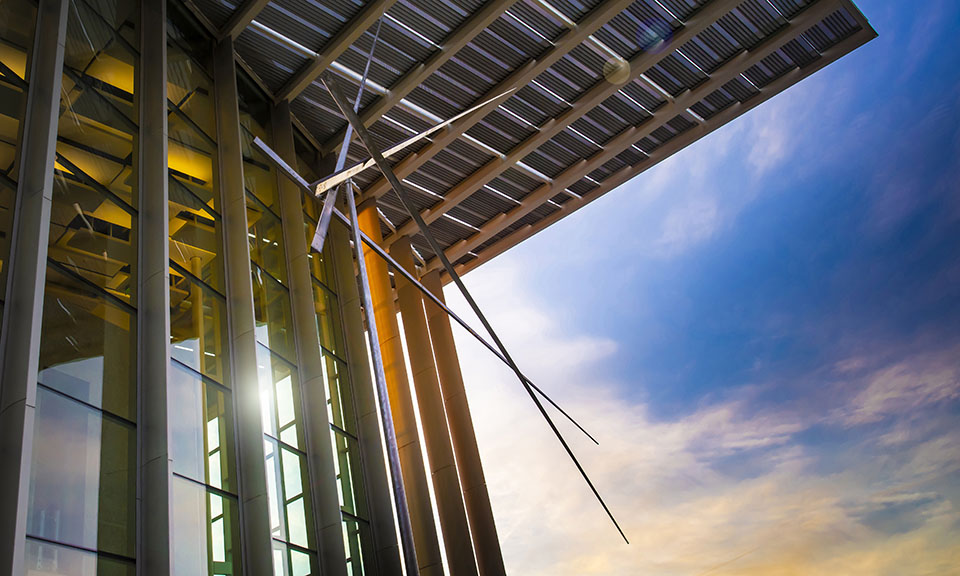
“Two Up, Two Down,” a stainless-steel kinetic sculpture by artist George Rickey, catches the early-morning light in front of the Younes and Soraya Nazarian Center for the Performing Arts at CSUN, in January 2020. Photo by Lee Choo.
In 1968 at Valley State, the area southwest of the Administration Building (renamed Bayramian Hall in 2005) featured a reflecting pool. The space is now occupied by Bayramian Lawn and a towering grove of trees. In the original reflecting pool, Valley State installed a stainless-steel kinetic sculpture, “Two Up, Two Down,” by artist George Rickey. The pool was relocated a couple of times, but the sculpture remained.
After the 1994 earthquake caused extensive damage and many years of reconstruction on campus, university officials saw an opportunity for a new and more prominent home for the sculpture. In 2010, when The Soraya opened on Nordhoff Street, the university added a stunning, new reflecting pool in front of the center — and “Two Up, Two Down” found the perfect new home. Visit in early morning or at sunset, when the blades of the sculpture catch the rising or fading light.
Rickey is one of “the most prominent of the artists whose work we have on campus,” according to Jim Sweeters, former longtime director of the CSUN Art Galleries, which also manages the public art on campus. “The sculpture was originally [intended] to be over water. It looks terrific where it is — we think [The Soraya] is the perfect location.”
“CSUN Sculpture” (aka the “worms” or “noodle sculpture”)
Corner of Zelzah and Nordhoff, campus map coordinate G-1
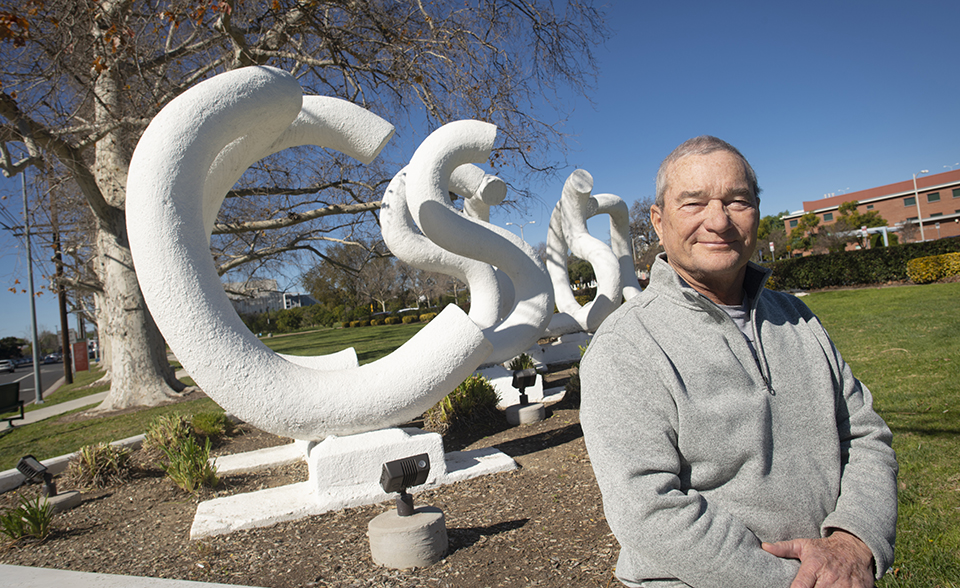
CSUN Alumnus John Banks with his award-winning design for the CSUN sign in 2023. Photo by Lee Choo.
Are they snakes? Are they worms? What are they, exactly? The beloved CSUN landmark — an avant-garde, 3-D, lower-case “csun” sculpture — at the corner of Nordhoff and Zelzah is nicknamed the “worms sculpture” or “noodle sculpture.” The sculpture was built in 1973, the same year the CSUN Library opened, and just two years after the university was renamed California State University, Northridge. The sculpture is a perennial favorite location for graduation photos and curious visitors to the Valley.
Nestled in a rich, verdant rose garden near the orange grove and Monterey Hall, the artwork was designed (and later built) by student John T. Banks ’72 (Art), M.A. ’94 (Three-Dimensional Art).
The CSUN Sculpture celebrated a big birthday this year: 50 years since it was selected the winner of a 1973 contest to design a sign for the university.
“I was an artist with ideas that needed to be explored,” Banks said this spring, when he visited campus to celebrate the sculpture’s half-century. “The CSUN Sculpture did launch my career in art because now, I have sculptures and public art in 38 cities in eight states.”
“Heavenly Hands”
In front of the Art and Design Center, Plummer Street, campus map coordinate D-6
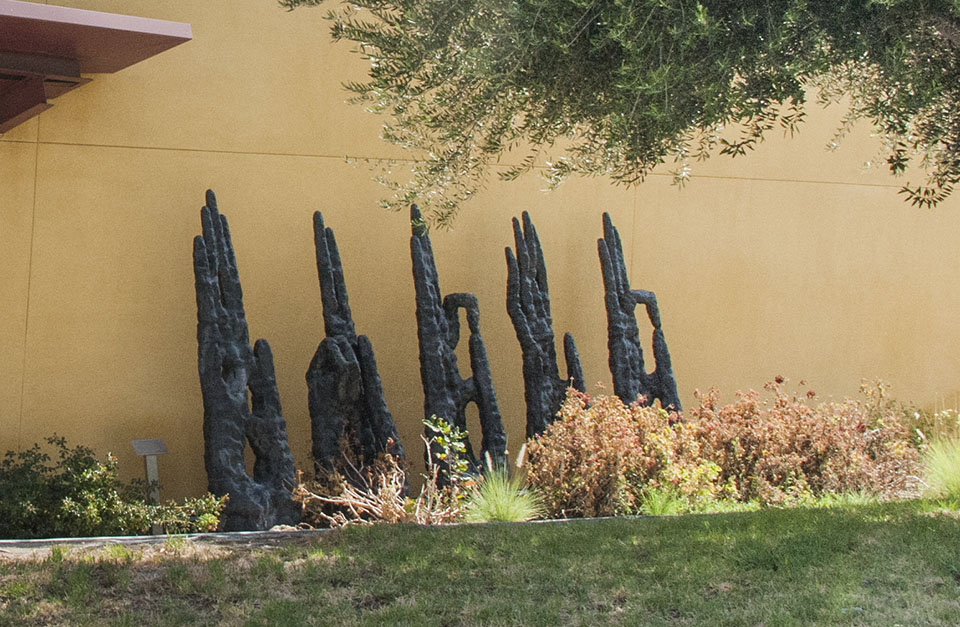
Installed in 2005, “Heavenly Hands” are the work of Romanian artist Patriciu (Patrick) Mateescu. The hands stand sentry in front of the university’s Art and Design Center. Photo by Patricia Carrillo.
Crafted in porcelain and glazed, the dark hands look as if they’re forming symbols or words. From another angle, they look as if a giant could have formed them as sandcastles on a beach. Installed in 2005, “Heavenly Hands” are the work of Romanian artist Patriciu (Patrick) Mateescu. They were donated by CSUN engineering professor Ileana Costea and alumnus Ion Baroi, and Costea arranged for the artist to fashion and fire the work right on campus, as artist-in-residence. (Baroi serves on the board of the Hamangia Foundation, which recently established a new scholarship in ceramics in the Department of Art.)
The hands stand sentry in front of the university’s Art and Design Center, where thousands of art students have studied over the years. The complex is also home to the CSUN Art Galleries.
“The ‘Heavenly Hands’ are religious symbols of Byzantine influence, strange formations of the clouds evolving from the sky or maybe directly from divine transcendence,” Mateescu wrote.
“Unbound”
Adjacent to Bookstein Hall, near the Arbor Grill, campus map coordinate C-5
“Dancer”
The Soraya courtyard, campus map coordinate F-1

Artist Soraya Sarah Nazarian, an internationally recognized sculptor who works with Carrara marble, unveiled her sculpture, “Unbound,” in Feb. 2018. Photo by Lee Choo.
A striking marble sculpture, “Unbound” stands at the crossroads between the David Nazarian College of Business and Economics, the Education Building and the Arbor Grill dining complex. At 4 tons and approximately 15 feet high, it’s tough to miss.
The name of the artist is also familiar: Soraya Sarah Nazarian, proud Matador parent of the business college’s namesake, David ’82 (Business Administration). An internationally recognized sculptor who works with Carrara marble, Soraya Nazarian’s sculptures have been commissioned by institutions including Milken Community School’s Saperstein Middle School campus in Los Angeles, the Hebrew University of Jerusalem and University of Haifa, Israel.
“Unbound” was her first artwork for CSUN, and in 2018 she completed another, “Dancer,” installed at The Soraya’s courtyard in 2021.
“Stone is hard, but it also has life,” she told the Los Angeles Times in 2017, when “Unbound” was installed on campus. The sculpture is made up of six stacked marble blocks of varying shapes and colors. The diversity of the stone reflects the diversity of CSUN’s students, according to the artist.
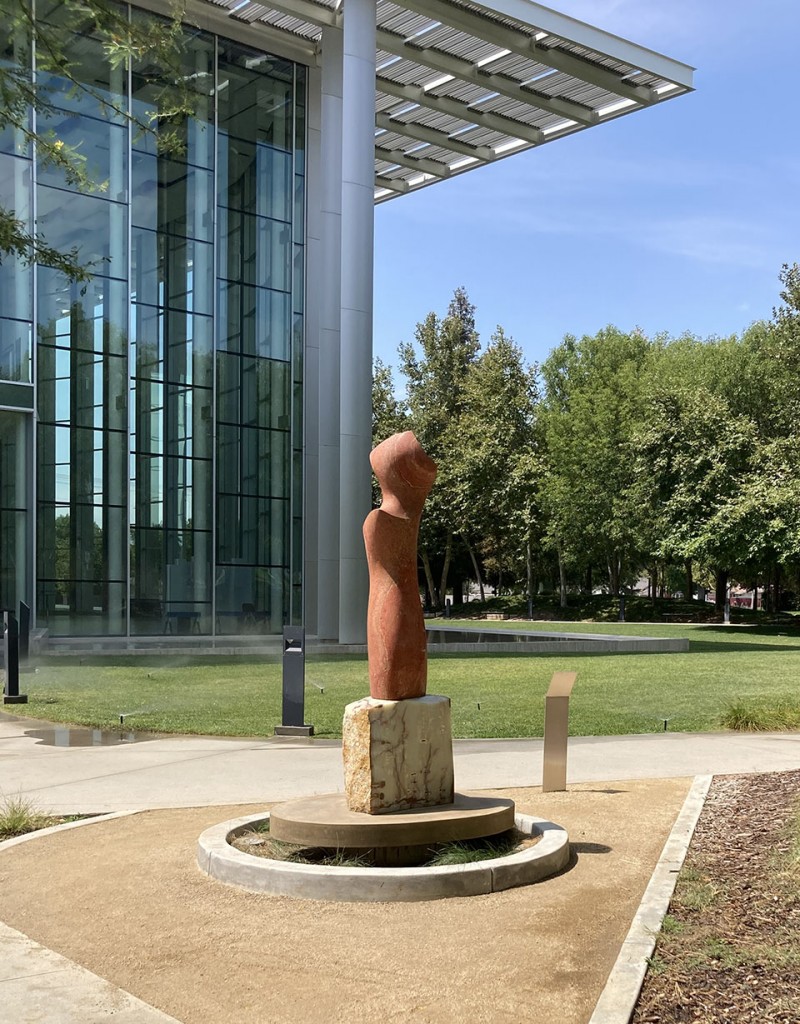
“Dancer” by Soraya Sarah Nazarian graces The Soraya Courtyard. Photo by Robert Sheridan.
Other notable sculptures to explore around campus:
“Wind Motion Column” by John Canavier, east side of Johnson Auditorium (Jacaranda Hall courtyard), campus map coordinate E-5
Sculptures and other public artworks by students in CSUN’s Public Art Course — University Student Union, campus map coordinates F-4 & G-4
Offered to students to develop the skills required to plan, propose and complete a public artwork during the academic semester, Public Art Course faculty collaborate with the University Student Union (USU) to provide space, audience and financial support to fully realize students’ artistic ideas. Some sculptures are located inside the Student Recreation Center, while others are installed outside of the USU’s Oasis Wellness Center. For more, see https://www.csun.edu/usu/art-collection/explore.
The CSUN Art Galleries will present a retrospective of late professor emeritus Bob Bassler’s work: “Permutations: The Work of Robert Bassler,” Aug. 28-Oct. 14, 2023. An opening reception is scheduled to take place from 5:30 to 8:30 p.m. on Thursday, Sept. 7 at the Main Gallery.


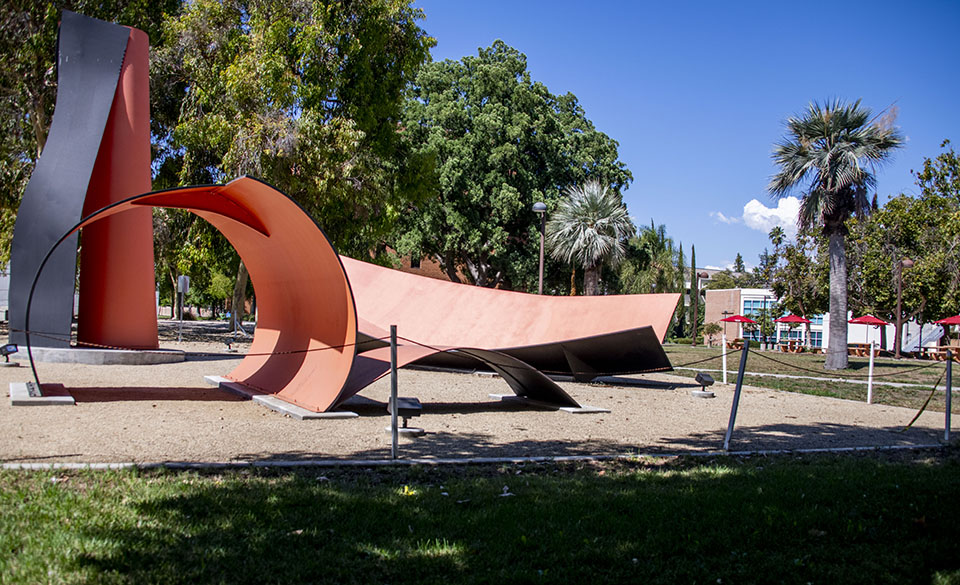
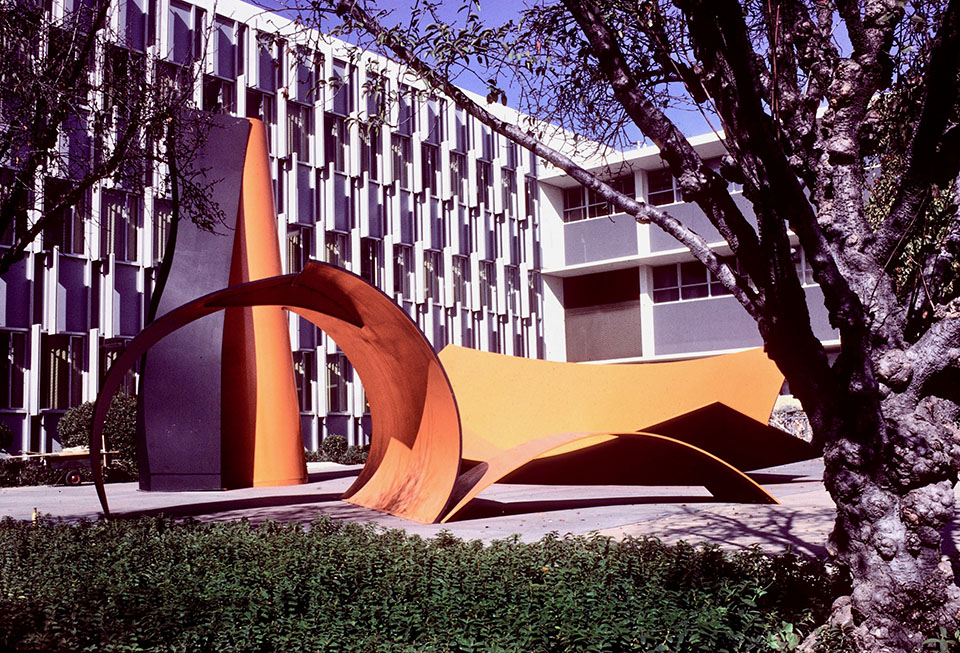

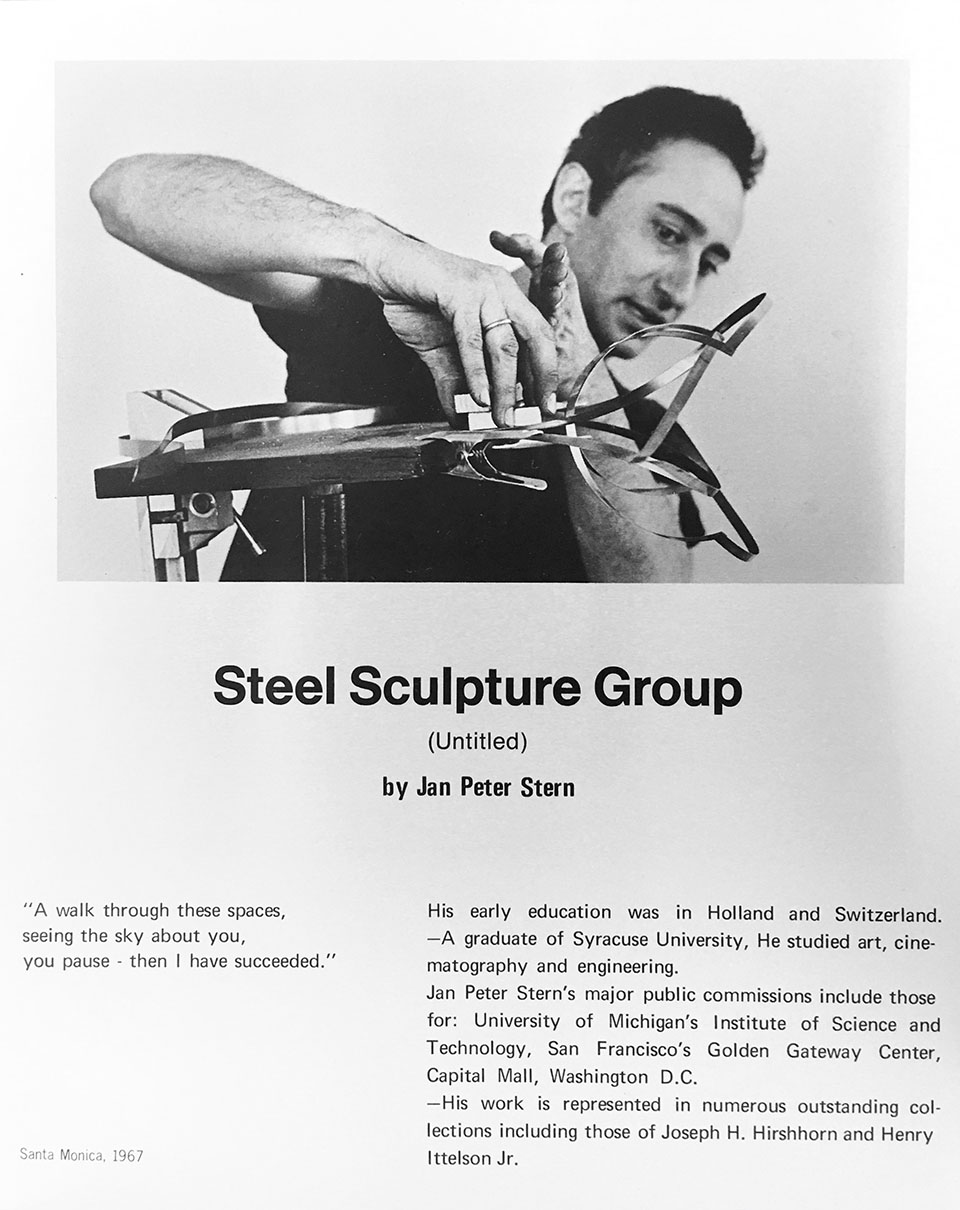

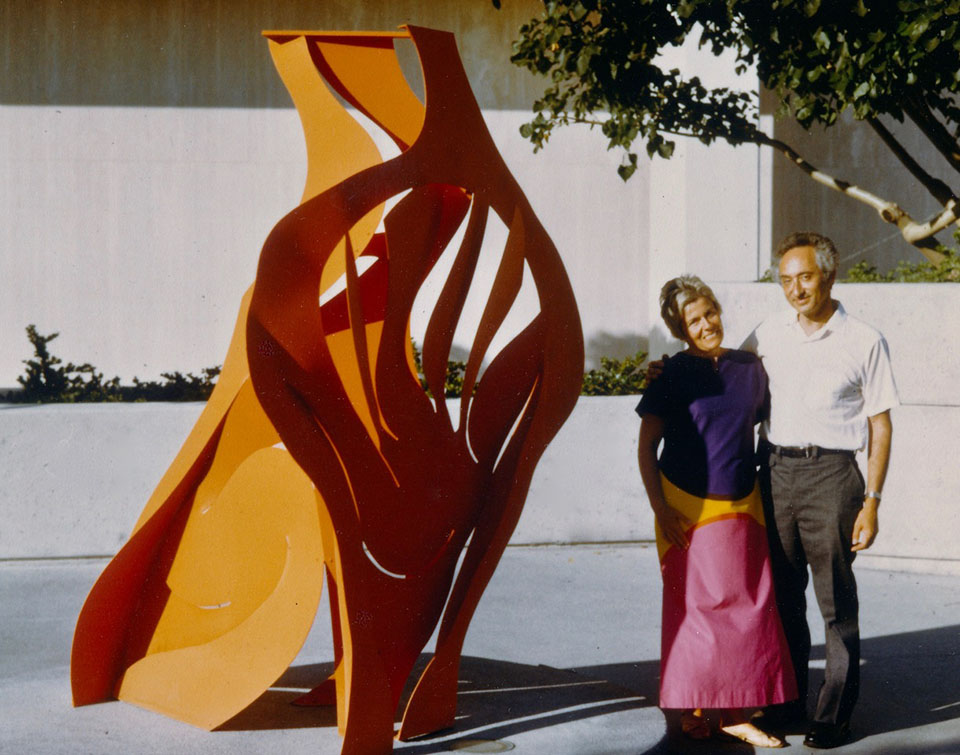
 experience
experience